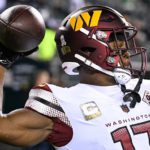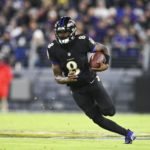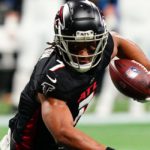Which NFL rookies will break out this year?
By Calvin K (Twitter: @Calvin_SGF)
A feeling of excitement is in the air, as NFL training camps are underway and the inaugural preseason game is in the books. Last Thursday’s Hall of Fame Game marked the beginning of the league’s 102nd season, and it will be the second straight year taking place during the COVID-19 pandemic.
Every year, perhaps the most exciting part of training camp is getting to finally see new rookies in action on an NFL practice field. For those rookies, training camp is crucial to learn their new systems and develop as players, and the practices also allow fans to get inside glimpses into how the preparation is going. As usual, many rookies will have an immediate impact in the NFL and in fantasy football, while others will take a while to develop and some may never have a significant impact in the fantasy world. In this article, I’ll be analyzing some rookies to target, rookies to avoid, and other interesting names that you should know heading into your fantasy draft.
Rookies to Target
1. Ja’Marr Chase (WR, Cincinnati Bengals)
Chase is considered perhaps one of the best wide receiver prospects we’ve seen in the last decade, and for good reason. There really aren’t any major flaws in Chase’s college film, and opting out of the 2020 season allowed him to focus on minor refinements that presumably made him a more complete receiver. With a great release, excellent hands, and electric speed, he should step in right away as an impactful NFL receiver.
Reuniting with his college quarterback in Joe Burrow is a major plus for Chase’s fantasy value, and the immediate connection between the pair, as well as the draft capital (#5 overall) spent on Chase implies that he will soon be the Bengals’ top wideout. Tee Higgins and Tyler Boyd are both very good receivers as well, but neither of them have the same explosiveness, athletic traits, and dominating play style of Chase. Burrow was also on a 16-game pace of 646 passing attempts last year, a number that would’ve been close to the top of the league. With A.J. Green no longer in the fold, that number is plenty to support all three Bengals wide receivers, and Chase’s upside means he projects to be the best of the bunch in year one and beyond.
2. Javonte Williams (RB, Denver Broncos)
The Broncos made sure to acquire Williams in this year’s draft, moving up five spots to #35 overall and getting the guy they’d set their sights on. Williams will have to compete with Melvin Gordon for the lead role in the Broncos backfield, but his abilities as a tackle-breaker and a pass-catcher mean that he could soon be a three-down back for the team.
Gordon will be a free agent after this year, so it seems obvious that the Broncos would consider Williams to be their future. It gets trickier to project Williams’ 2021 playing time, but his punishing running style means that he could see the field early and often. Williams had easily the highest tackle-breaking rate in the FBS last year, and if that translates to the NFL level, it could mean staggering efficiency, which is something we don’t always see from pure north-south runners.
Strength-of-schedule can be a stat that changes drastically mid-season, but even so, the Broncos’ late-season schedule can still be considered a cause for excitement. After their Week 11 bye, Denver only plays one team above the bottom 10 in points per game allowed, setting Williams up for a potential backfield takeover at a perfect time. We could see a Jonathan-Taylor type breakout from Williams in Weeks 12-17, and league-winning performances in those weeks would certainly make up for a potentially slow start to the year (which may not even happen, given camp reports saying he’s expected to compete right away). Overall, Williams’ talent combined with circumstances could yield a great year for him in fantasy, which is why he’s more than worth a selection at his RB27 price.
3. DeVonta Smith (WR, Philadelphia Eagles)
Smith has a major opportunity to step up in Philadelphia, and in my opinion, he should’ve been picked over Jaylen Waddle at #6 overall. Smith and Chase have many similar traits, as Smith also has consistent hands and gets off the line fast. However, Smith is arguably the better route runner of the two consistency-wise, which then leads to the sensible assumption that the sole reason Smith dropped in the draft was his BMI.
At 6’0″, 174 pounds (166 at his combine), Smith’s weight is lower than essentially every successful wide receiver ever, even weighing in lower than players such as Marvin Harrison and Will Fuller. However, as the first WR to win the Heisman Trophy in 29 years, Smith has established that he’s an outlier at the position. Smith stayed in great health throughout a grueling SEC season last year, and the concerns about injury risk tend to be overblown when you consider that he only missed two games due to injury in his entire college career. Now in the NFL, he should have a great chance at immediately being the Eagles’ top receiver, as his only major competitor for targets is likely to be tight end Dallas Goedert. If he starts for most of the year (which, barring injury, he almost certainly will), he has the potential to be a top-20 fantasy wide receiver, making his current WR39 FantasyPros price feel like his absolute floor.
4. Elijah Moore (WR, New York Jets)
At WR62 on FantasyPros, Moore is set up to be a tremendous value, one that you can get at the very back of your draft. Moore has top-30 WR upside in this new-look Jets’ offense, and while his true breakout isn’t likely to happen in 2021, he still has lots of potential to make noise alongside fellow rookie Zach Wilson.
Wilson’s arm talent allows him to place throws where only his receivers can get it, which is a perfect match for Moore, a speedy receiver with excellent hands and pure, consistent route-running ability. Corey Davis, a veteran, will likely be Wilson’s favorite target early in the season, but Moore’s superior big-play ability will likely translate into a higher target share as the season goes on. Moore could easily end up being the #1 target for New York, but even if he’s not, he can still succeed as the WR2 in what’s likely to be a pass-first offense. Moore has the ability to score long touchdowns and make big plays, but he also was consistently an open target at Ole Miss, which could mean big things for him in the NFL.
Rookies to Avoid
1. Michael Carter (RB, New York Jets)
Carter is not a terrible player to take a shot on late in drafts, but the fourth-round RB is inexplicably ranked 19 spots ahead of Tevin Coleman, who is likely to have more success this year. Fourth-round RBs have an extremely low hit rate, so it makes much more sense to project New York reliance on Coleman, who has a solid 4.2 career yards per carry.
2. Rondale Moore (WR, Arizona Cardinals)
Moore is currently FantasyPros’ WR72, and at that price, he’s a fine player to take a shot on. However, I wouldn’t expect a breakout season from him this year. Christian Kirk is already established as a valuable piece for this Cardinals team, and with the addition of A.J. Green this offseason, it could be difficult for Moore to find a role in the offense.
Moore is incredibly fast, and his burst may be unmatched by any receiver in this draft class. However, he isn’t a dominating type of player, and his speed often is the only tool he uses to win matchups. This isn’t necessarily a bad thing at all for his potential success in the NFL, but it seems likely that this skill set will primarily be a situational one in 2021. As a gadget guy, Moore will be able to throw defenses off balance, but his skill set doesn’t project to him being a high-volume receiver, which could cause him to be inconsistent and disappointing for your fantasy team. Moore certainly has tons of talent, and he could even become a player similar to Tyreek Hill at some point, but we’ve seen many recent examples of speed being overhyped in the NFL (Andy Isabella, Jalen Reagor, Henry Ruggs, etc.), which is why Moore carries a lot of risk and not a ton of reward for this year.
3. Trey Sermon (RB, San Francisco 49ers)
Sermon, who the 49ers selected in the 3rd round of this year’s draft, has some upside, and in the long-term, he could be a very solid RB. However, it’ll be difficult for him to carve out a role this year given the amount of backfield competition in San Francisco.
Raheem Mostert will be a free agent after this year, so Sermon will have an opportunity to be this team’s lead back in the future. However, it’s hard to see him becoming the clear lead back in 2021 while competing with Mostert, Jeff Wilson, and others for touches. The 49ers like to use a running-back-by-committee approach, and Kyle Shanahan likes to run with the hot hand, an approach that can favor a healthy Mostert, who is extremely explosive and efficient. As a third-round RB, Sermon’s hit probability is also much lower than someone like Javonte Williams, so it’s probably unwise to expect a ton from him year one. He’s a fine late-round flier, but his RB35 FantasyPros ranking likely means someone in your league will put at least somewhat of a premium pick on him, which just doesn’t appear worth it in redraft.
Other Names to Know
Kyle Pitts (TE, Atlanta Falcons)
Pitts is an incredible athlete, and he’s in consideration as perhaps the best tight-end prospect in the history of the NFL. Pitts became the first non-QB off the board when the Falcons selected him at #4 overall, and at 6’6″ and 240 pounds, he has the perfect build for a dominating tight end. His athleticism means he can be a vertical dominating threat who can win 50 50 balls consistently, and he has a willingness and an underrated talent for blocking as well, which can’t even be said about some of the league’s better tight ends. However, almost every rookie at the tight end position doesn’t immediately have a massive target share in year one. Pitts’ generational talent means that he could be a superstar right out of the gate, but the early-season risk places him as my TE6 overall for this year.
Travis Etienne (RB, Jacksonville Jaguars)
Etienne is a frustrating case because the Jaguars’ selection of him at #25 overall placed him into what should be a heated backfield battle with fellow RB James Robinson. Robinson shined in his rookie season after going undrafted last year, but the addition of Etienne likely means he won’t handle close to the historically high snap share that came his way last season. The Jaguars will be better as a team this year, which should help both RBs, but the fact remains that they both are talented, and they will continuously eat into each other’s workloads. Etienne’s main breakout will be in the second half of the year when he’s gotten some NFL experience, but even then, a true emergence could be difficult to pull off given Robinson’s presence. Due to all of this, Etienne is my #28 fantasy RB for next year, and while he does have some upside, his risk is too high for me to want him as my RB2.
Rashod Bateman (WR, Baltimore Ravens)
Bateman, the Ravens’ first-round wide receiver out of Minnesota, is an electric player with many highlight-reel-worthy plays on his college tape. However, he will, unfortunately, be part of a Ravens offense that just doesn’t throw the ball enough to give Bateman tons of upside. Ravens quarterback Lamar Jackson had 376 pass attempts in 15 games last year. In contrast, Bengals QB Joe Burrow had 28 more attempts while playing in just 10 games. This limited volume will cap Bateman’s ceiling and limit his consistency, and with an elite tight end in Mark Andrews already established as this offense’s top target, it’ll be hard for the rookie to breakthrough in year one. Marquise Brown and Sammy Watkins will also fight for the team’s #2 role, and fourth-round pick Tylan Wallace is in the mix as well. All of these factors don’t necessarily mean Bateman won’t succeed, but they certainly make it much more difficult for him to be consistently productive in fantasy.
Jaylen Waddle (WR, Miami Dolphins)
Waddle is joining a confusing situation in Miami, and although he will reunite with Tua Tagovailoa, his college QB, there are a lot of question marks surrounding his fantasy potential. Tua’s inconsistency last year is one cause for concern, and while we know he has lots of arm talent, it remains to be seen if he can produce at the NFL level. Another issue for Waddle will be the Dolphins’ supporting cast. Will Fuller and Mike Gesicki should both handle significant receiving work, and with DeVante Parker, Myles Gaskin, Preston Williams, and Albert Wilson also vying for targets, it could be difficult for Waddle to carve out an established role. Finally, while Waddle is an electric player, he’s not necessarily a very complete WR. His hands are a major question mark, and this could cause him to become more of a gadget guy for the team, with a large portion of his touches coming at or near the line of scrimmage. Gadget roles usually aren’t overly consistent on a week-to-week basis, and while manufactured touches could help his touch share overall, they may not be reliable enough to immediately help your team this year. In the dynasty, Waddle will have much more time to develop a significant offensive role, but for this year, there are a lot of hurdles to overcome, which is why his immediate production potential appears limited.
First-Round QBs
All five first-round quarterbacks could make a fantasy impact this year, but it’s not necessarily likely that any single one will put up amazing stats in Year 1. Trevor Lawrence is the consensus rookie QB1 for redraft, and while he has a good arm and some rushing upside, he doesn’t have the same rushing explosiveness as players like Lamar Jackson and Kyler Murray. Lawrence has solid weapons in Jacksonville, but overall, there’s not really a reason to believe that he should be drafted above other established veterans at the position. Zach Wilson’s arm talent is incredible, but coming from a non-Power Five school in BYU could mean that it takes him some time to adjust at the NFL level. Trey Lance has great rushing upside, but he’s unlikely to start immediately for the 49ers, as they seem quite comfortable with Jimmy Garoppolo as the starter for now. I’d expect Lance, this year’s #3 overall pick, to see the field at some point this year, but it seems assured that he won’t provide a full year of fantasy production. The same thing applies to Justin Fields, who has great arm talent and speed. Fields also was an inconsistent decision-maker against the blitz in college, and those issues could be exacerbated when facing NFL defenses. Finally, Mac Jones of New England is likely to see the field least out of this group, and while he is an accurate passer, his rushing upside is extremely minimal, which will make it tough for him to provide big fantasy weeks.
Overall, there are many intriguing storylines to consider when evaluating rookies for your fantasy draft. I tend to believe that rookies are generally undervalued in redraft, which is why I have more major players to target than to avoid. Drafting rookies gives you a lot of upsides, and while they may disappoint early in the year, many will come through in a big way later on. That early-season disappointment can also give you a perfect buy-low window on some rookies, and while many will be good from the start of the year, others can sometimes be acquired for extremely low prices, making them likely to pay off on investment. Overall, you should make sure to have a good evaluation on a rookie and their surrounding players before making a selection. However, with the right knowledge, targeting rookies can be a great strategy to aid your chances of winning your fantasy league.





















Leave a comment